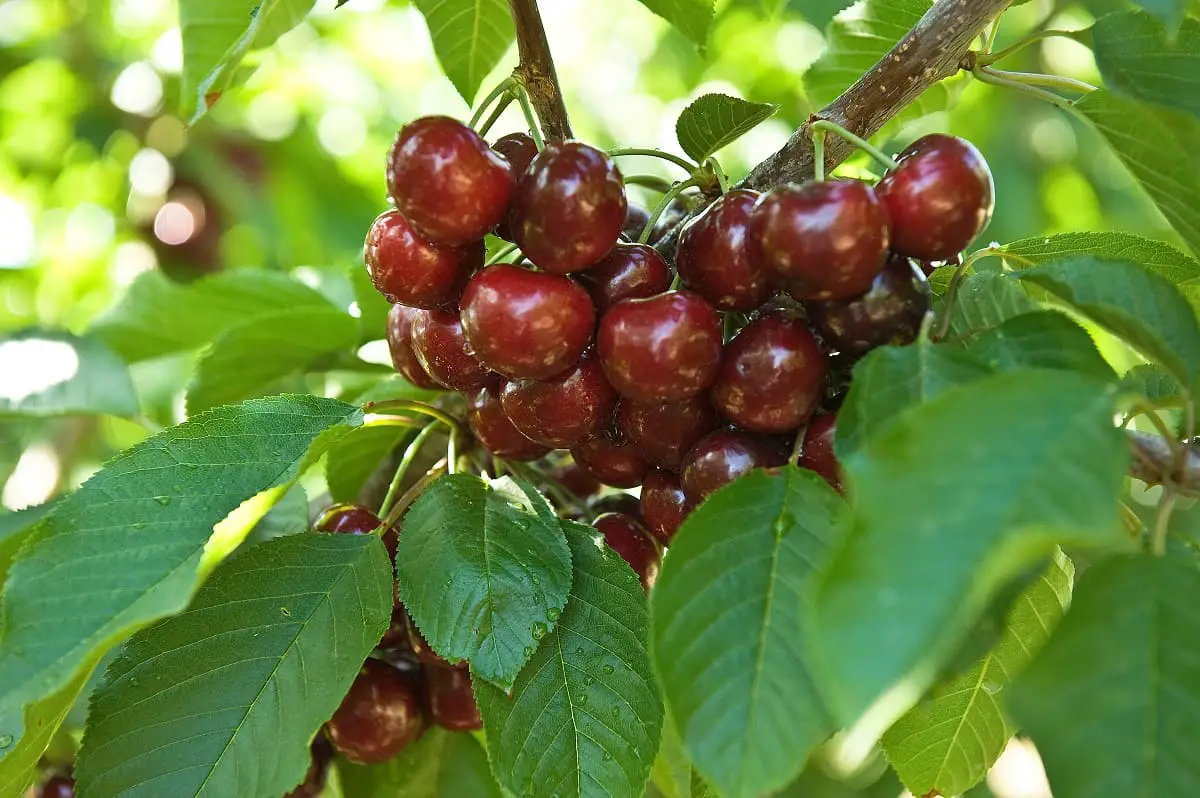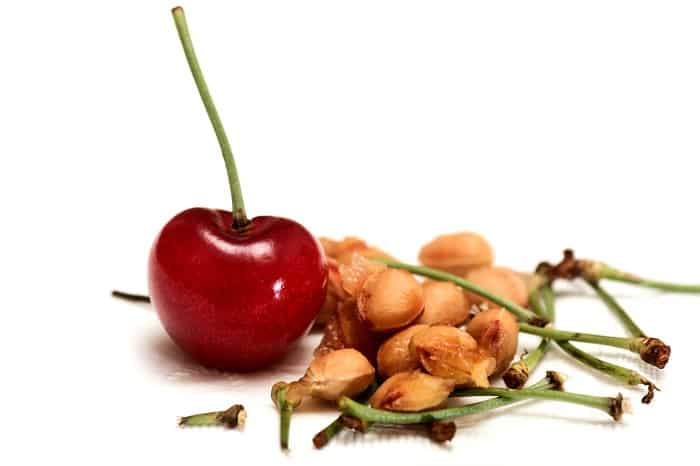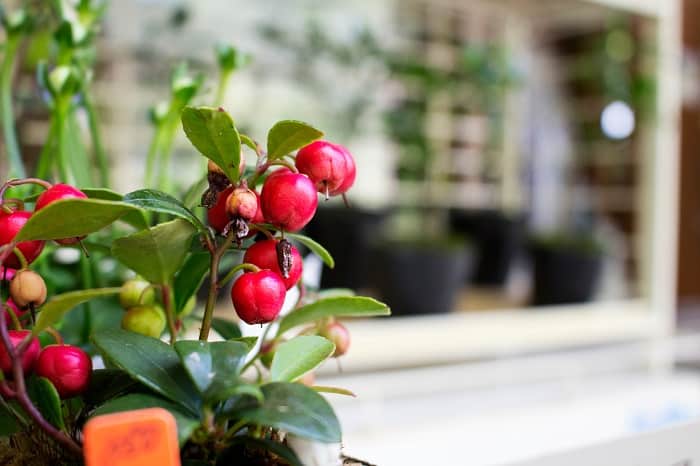Last Updated on January 24, 2023 by Tony Manhart
Can you grow a cherry tree from a pit? Almost everyone has heard of this legend but few individuals have taken the time and energy to test it. After all, many don’t make the connection between a large and beautiful cherry tree and the small hardy pits that are spat out during regular fruit consumption. The truth is that it is possible to grow an entire tree using a single cherry pit, although it will take some work. Before attempting to grow a cherry tree, remember these trees only grow in hardiness USDA zones 5-9 and will thus not bloom in climates that are too hot or too cold.
Do You Have to Dry Cherry Seeds Before Planting?
We have often been asked, do you have to dry cherry seeds before planting? The answer is yes, it is an essential step to take when attempting to grow a cherry tree using a pit. Although the whole growing process is relatively easy to do, certain steps need to be followed to ensure that the cherry pits properly germinate. This will allow for a thriving cherry plant with abundant harvests.
When people ask me, can you grow a cherry tree from a pit, I often tell them that although they can, they need to take heed of a few tips and strategies when preparing their cherry seeds before planting.
Here are a few tips about cherry seed preparation:
- – Ensure that the cherry seeds or pits that you are using are first cleaned of all the fruit before your start planting preparations.
- – Thereafter, it is vital that you dry the seeds for the next week or so. Choose a warm dry place that does not get direct sunlight.
- – Then, once they have dried, wrap the seeds in a damp paper towel and store them in a jar or plastic bag for the next two and a half months. This procedure is vital as it enables seed germination.
The stratification process which it is known by is done to create a wintery environment when the seeds usually lie dormant before the growing season.
Can You Grow a Cherry Tree from Store-Bought Cherries?
So, can you grow a cherry tree from store-bought cherries? Although the answer is yes, you can use store-bought cherries to grow a tree, there are a few things that we would like to bring to your attention. Although locally-grown cherries will do well in their native environment, they will take longer to develop when growing from seed. But, they offer several benefits even though the growing process is extended. This is also the most inexpensive way to grow a cherry tree in your home or garden.
So, if your farmers market stocks grew cherries, then you’re in for a win if you follow the seed preparation process to a T. However, if you don’t know where the cherries are sourced from, then you may have some difficulty in growing them. This is because it may not be compatible with your zone depending on the variety. Keep in mind that overly hot or cold climates are not suitable for growing these plants as they prefer consistent moderate weather conditions to thrive. So, you no longer have to wonder, if can you grow a cherry tree from a pit because you now know it’s quite possible. Ensure that you make use of well-draining soil when planting them.
How to Plant a Cherry Seed?
So, now that you know about the germination process, what about learning how to plant a cherry seed? Many gardeners indeed opt to purchase young trees from their local nurseries rather than growing them from seed. But for those who like the challenge of nurturing the cherry pits and planting them, knowing how to plant them will be very beneficial. This is because hard work does pay off in this instance, affording the grower eye-catching fragrant plants that burst with abundant yields.
Spring harvesting would be an added joy with the addition of a delicious cherry tree in your very own garden. However, the process is much lengthier as you can expect the tree to bear fruit in about 7 to 10 years. This fact will also depend on the variety you have planted because sour cherries produce fruit much more quickly. You should also keep in mind that some cherry trees are grown from pits but don’t produce any fruit.
Although we have provided the answer to the question, can you grow a cherry tree from a pit, you should find out whether the seed you want to plant was locally sourced or not. This will enhance the chances of planting a cherry seed that fruits.
Here are the steps and tips to plant a cherry seed:
- To begin, ensure that you make use of well-draining soil to plant your cherry seeds.
- Your plant pot should also have drainage holes to get rid of any excess water.
- After your cherry seeds have gone through the germination process, you can plant them. It is advisable to plant three seeds per pot for the best results.
- Planting them in the early spring season or late fall is recommended for favorable results.
- If they are planted in pots, ensure that the container is placed at a south-facing window with bright light.
- Ensure that the soil stays damp and doesn’t completely dry out.
- Cherry plants thrive in moderately warm conditions and should begin to sprout from the surface of the soil after about 14 days or so.
- Look out for your cherry plant to produce its second set of leaves before transferring the seedlings into individual pots.
- A fully grown sweet cherry tree should offer a yield of between 30 and 50 quarts of fruit yearly while about 15 quarts can be expected if you’re growing a dwarf variety.
How to Plant Cherry Seeds from a Pit
The first step to planting a brand-new cherry tree is to find some fruit. Cherries bought from a grocery store are unlikely to produce healthy pits that will spawn a new tree. This is because the methods used for preservation, including basic freezing, damage the pits. Instead, grab some cherries from a local tree or head to a farmer’s market and pick up a batch. These will not only be healthier but come from a tree that has already been successful in growing in your current climate.
Pit Preparation
Once you have some cherries, you can start to separate the pits. This can be done by eating the cherries on your terms and then storing the pits in separate containers, or you can slice the cherries open, refrigerate the fruit, and get ready to prepare the pits. Pits that have been exposed should be soaked in a bowl full of warm water for five minutes and then scrubbed to remove pulp and leftover fruit.
Cleaned pits can then be allowed to dry on a paper towel in a warm area for 3-5 days. Once dry, transfer them to a dry, airtight container and store them in the fridge for ten weeks. Remember to label when the pits went in the fridge, or you’re liable to forget.
Facts about How To Plant Cherry Seeds
After ten weeks, it’s time to remove the pits from the fridge and prepare them for planting. Allow the pits to warm up to room temperature, and then divide them into groups of two and three. Each group of seeds should be planted in a separate container using a planting medium with average nutrition and porosity. The containers should be exposed to regular (6 to 8 hours) sunlight and the soil needs to be kept moist.
After two weeks, saplings will have sprouted in the containers. Identify the healthiest ones and take these outside to plant. Planting is best done during the spring once the dangers of frost have passed. Remove the saplings and their soil from the containers and plant each one in a separate location. Cherry trees need to be at least 20 ft. apart from one another for the best results. To ensure maximum health and longevity, regularly mulch the area around the trees and ensure the saplings receive enough water to keep the soil damp. Over time, at least one of the saplings should be strong enough to become a tree.
How to Plant Cherry Seeds: How To Take Care
If you want your new tree to remain healthy and strong, it’s important to do some research on what will make the cherry tree successful. First and foremost is making sure the saplings are planted in deep, well-drained soil that will allow for root growth. These fruit trees need to be separated for maximum root expansion, and the roots will not thrive unless they break through the soil. It’s a good idea to till any region where you want to plant before you move the pit saplings.
Another key thing to understand before planting is knowing the difference between sweet and sour cherries. Sweet cherries are the ones found in grocery stores and are fitter for human consumption than sour models, which are attractive to birds and wildlife. Sweet cherry trees are not self-pollinating. This means if you want the tree to grow fresh fruit each year, there needs to be another sweet cherry tree in the area to provide necessary pollination.
Some other important care tips for cherry trees are:
- Sweet and sour cherries can be cared for in the same way
- Avoid pruning the tree in the fall, as this leaves the branches exposed to the cold
- Apply mulch regularly throughout the spring and summer
- Prune the trees in late winter
- Keep saplings well-watered and in moist soil until they reach 3 ft. tall
How to Plant Cherry Seeds: Recommended Varieties For Planting
While most cherry trees should be planted in late spring, some varieties grow well during the summer and early fall as well. In general, gardeners who enjoy sweet cherries should stick to Black Tartarian in spring, Bing during the summer, and Stella during the fall. If gardeners want to grow sour cherries for the animals or for preserving for jam, then the best varieties are Early Richmond for the spring, Montmorency for the summer, and Meteor for the fall.
If you can buy other varieties or favor one cherry over another, you can repeat the process of isolating and preparing the cherry pits for growing. Just remember to plant the saplings that come from the pits during the right season, or the sapling is liable to decay and die from poor nutrition.
Conclusion
It is possible to grow a cherry tree from a cherry pit, but it will take some work. Although it is tempting to head down to the nearest grocery store and buy a bag of cherries, this won’t always work. Instead, you need to research some local varieties, find a farmer’s market, and purchase from the nearby area to ensure the trees grow effectively. You will also need to plant more than one tree if you enjoy sweet cherries because these varieties do not self-pollinate. But once you have isolated the pit and are ready to plant, the sapling and ensuing tree will reward you with delicious fruit for years to come.
Now that you know the answer to, can you grow a cherry tree from a pit, why not give it a shot and enjoy abundant harvests?
FAQs
How long does it take to grow a cherry tree from a seed?
The average time it takes for a cherry tree to grow is about six years. It starts to grow when the seed is about one month old and it reaches full adulthood in six years.
Do you have to dry cherry seeds before planting?
There's a lot of confusion about whether you need to dry cherry seeds before planting them and the answer is a little complicated. Some experts say that yes, you do need to dry cherry seeds before planting them but it's all dependent on the type of soil that your plant will be growing in.
How fast do cherry trees grow?
The speed at which cherry trees grow depends on their age, climate, soil, and other factors. The general rate of growth is about 6 inches per year.
What month do cherry trees produce fruit?
Cherry trees typically produce their fruit in the fall.
The fruits are usually smaller and red, with a cherry-like appearance, and are harvested in early October to mid-November.
Where do cherry trees grow best?
The best place to grow cherry trees is a temperate climate with ample rainfall. They require plenty of sunlight and good soil.
How do I grow a cherry tree in my backyard?
Cherry trees are typically grown in a very specific climate, so you will need to find out what type of soil and location is best for your cherry tree before you can decide whether it would be feasible as a garden plant.
Mature trees should be planted at least 2 feet apart. You will need to water them regularly and fertilize them each spring. Plan on pruning the lower branches of the tree once they develop into long, thick, woody stems that appear pretty much like bottlebrushes attached to the trunk of the tree.
Can apple and cherry trees be planted together?
When planting trees, people often get a little carried away with the number of seeds they plant. If you're planting apple and cherry trees in your backyard, you'll need to consider how many seeds per tree you should plant.
Planting apple and cherry trees together can create some interesting results. You could end up with an apple-cherry hybrid tree that has characteristics from both or a regular apple or cherry tree with a few apples or cherries planted closer to each other than usual.
Some things that make it hard to plant apple and cherry trees together are their difference in water needs, size of root systems, fruit size and ripening time frame.
The two trees can be planted in pots and then placed next to each other.
Apple tree has a round shape with a tannin, a compound that gives the leaves an astringent taste and which protects them from fungus. Tannin also prevents bacteria from colonizing the tree's bark. Cherries have acid fruit and soft stems which are often not strong enough to support the weight of their fruit.
So, it is safe to plant apple trees next to cherry trees since they don't compete for nutrients or water sources with each other and are compatible because of their different needs.
Do cherry trees self pollinate?
Self-pollination is a process in which the pollen grains from one plant fertilize another plant of the same species, with an effortless transfer of genetic material. This process prevents inbreeding and ensures that plants maintain their genetic diversity.
Cherry trees are able to pollinate themselves because they have a special structure within their flowers called a pistil that allows pollen from one flower to reach the stigma of another.
Tony Manhart is a passionate gardener who has been tending to gardens for over 20 years. He takes pride in creating beautiful outdoor spaces with plants, trees, and shrubs that can thrive in any environment. He loves to share his knowledge with others and has taught classes on gardening basics and advanced techniques. He is committed to sustainability, using natural and organic methods to create and maintain gardens. He also works with local organizations to create green spaces for communities. When he’s not gardening, Tony enjoys hiking, reading, and spending time with his family.




